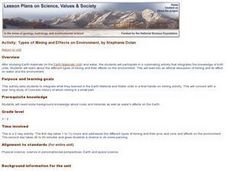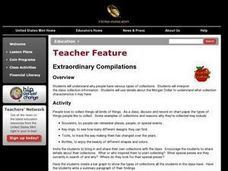Curated OER
Erosion and Deposition
Fifth graders study the processes of erosion, transportation, and deposition in soil. They walk outside the school to see examples and then accurately create a physical model which shows each type of soil movement and allows them to...
Curated OER
Wind
For this wind worksheet, students fill in 15 different question blanks that related to wind. First, they define wind erosion and what it picks up and why. Then, students determine the most common form of wind deposit and what type of...
Curated OER
Survey Says...
Students practice taking surveys to answer different questions about radio. In this communications lesson, students brainstorm to create questions they can ask strangers about how often they listen to their radio. Students...
Curated OER
Making a Soil Separator
Young scholars investigate botany by creating a soil separating device. In this plant life lesson, students identify the needs of plants and how important the right soil is in the growing process. Young scholars define...
Curated OER
Choose Your Own Soil Adventure
Ninth graders will use a soil survey to make management decisions and by interpreting geologic maps. The importance of different soil types is discussed and the implications of how soil can be useful for our communities.
Curated OER
How Does Water Cause Weathering?
Fourth graders explore the weathering process of water on rocks. They observe how water and friction from other rocks cause them to weather. Students discuss examine and discuss various rocks found on the playground, beach, etc. They...
Curated OER
Social Studies: Your Family Does What?
Sixth graders compare and contrast their own personal culture with that of Japan. They fill out questionnaires, compile the results, and match them with Japanese answers to the same forms. Students create a Venn diagram of the...
Curated OER
Mineral or Maceral Mosaic
Students study about geologists and their job. They also study that rocks are made up of minerals and organic material by conducting an experiment where they create their own "granite" or "coal".
Curated OER
Exploring Great Salt Lake
Fourth graders go on a field trip to make observations about plants in the Great Salt Lake area. They make observations about the environment and record the types of pants that are living there. The lesson is to introduce the concepts of...
Curated OER
Earth's Surfaces
Pupils identify and define geology and earth surface vocaulary and their meanings to classify rocks and explore caves and their properties. Students find rocks and test them according to Moh's scale. They create a color coded earth...
Curated OER
Model Professionals
Pupils learn about one scientist's quest to make her field of canopy ecology accessible to a wider audience and to synthesize their knowledge by developing toy figures that could potentially educate children about different scientific...
Curated OER
Structure of the Earth System
Eighth graders describe the steps in the water cycle. They discuss factors that affect runoff and explain the differences between stalactites and stalagmites. They discover the importance of ground water.
Curated OER
Reopen: A Study of Five Closed Mines
Students analyze data to determine which of the fived closed mines would be beneficial to have reopen. They acquire knowledge of rocks and minerals in the area to give reasons why that mine should open again. Students gain knowledge in...
Curated OER
Boombox Classroom: Ensembles
In this music worksheet, students identify types of ensembles. They order duet, quartet, solo, and trio by the number of performers in each. Students complete a word search, looking for ensemble related words.
Curated OER
Decomposing Artifacts
Seventh graders participate in an experiment in which they calculate the time of decomposition of different materials. In groups, they fill bags with different materials and cover them in soil. After six months, they create a line graph...
Curated OER
Studying Aquifers in Outcrop
Students describe two or more different rock types found in outcrop. Students look specifically at the hydro-geologic properties of the rocks and complete the lab with a paper explaining a scientific phenomenon in layperson terms.
Curated OER
Cemetery Geology
Young scholars examine the chemical and physical weathering process of different rocks in a cemetery based on dates on the stones. Students discover the susceptibility of different rock types to weathering.
Curated OER
Extraordinary Compilations
Learners discuss and record why people have various types of collections. They interpret the class collection of information then use details about the Morgan Dollar to understand what collection characteristics it may have.
Curated OER
Watch It Slide!
Students work together to examine inclined planes. They create a plan to raise rocks to build pyramids. They discover the changes that occur when the angle is increased or decreased.
Curated OER
Precipitates and Black Smokers
Students discuss how hydrothermal fluid is different from seawater and what happens to it as it passes through the oceanic crust. They observe and manipulate calcuim chloride and baking soda to comprehend how precipates form.
Curated OER
The Formation of Soil
Students identify the different components that make up soil. In this earth science lesson, students create a pamphlet for next year's class. They analyze how erosion and weathering shape the Earth.
Curated OER
Ride the Wild Leaf Cycle
Fourth graders explore plant life by completing an Internet activity. In this botany lesson, 4th graders identify the types of plants that grow locally and the different soils they utilize to survive. Students read assigned text about...
Curated OER
Are We Falling Apart? Exploding Volcanoes
Young scholars explore how volcanoes are formed, list the parts and characteristics of volcanoes, state the differences in various types of lava, and analyze the volume of ejecta from a volcano.
Curated OER
Build A "Bug"
Students brainstorm different adaptations that bug would need to live in aquatic environment, and watch presentation where classmate is dressed up in costume to represent adaptations necessary for macroinvertebrate to survive in water.

























